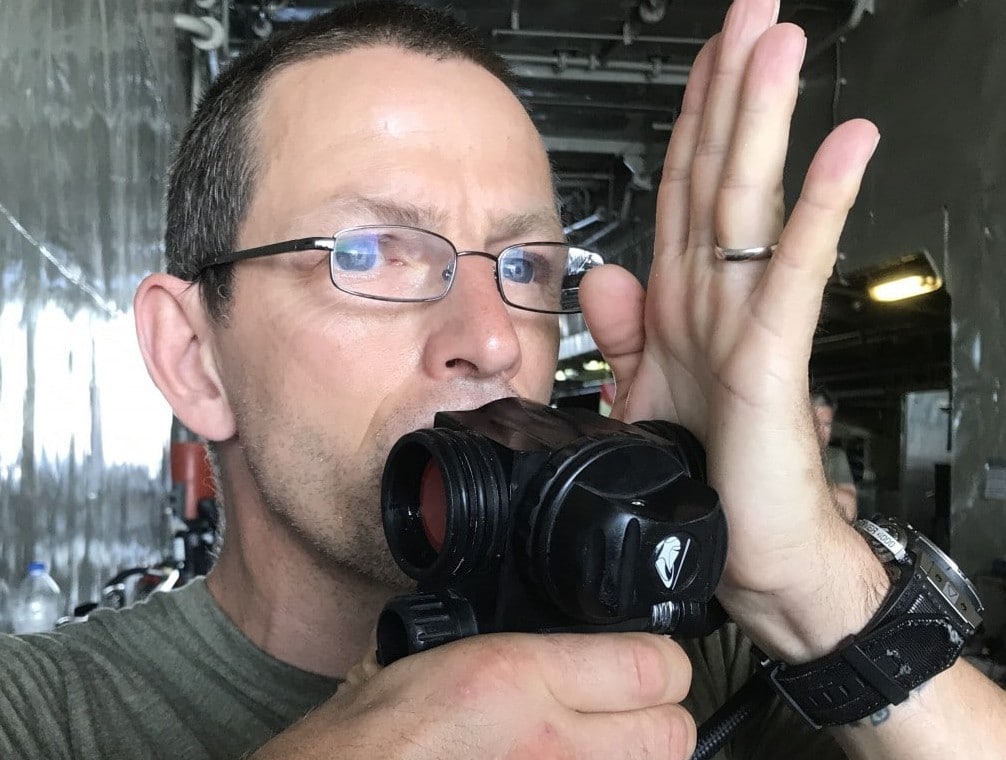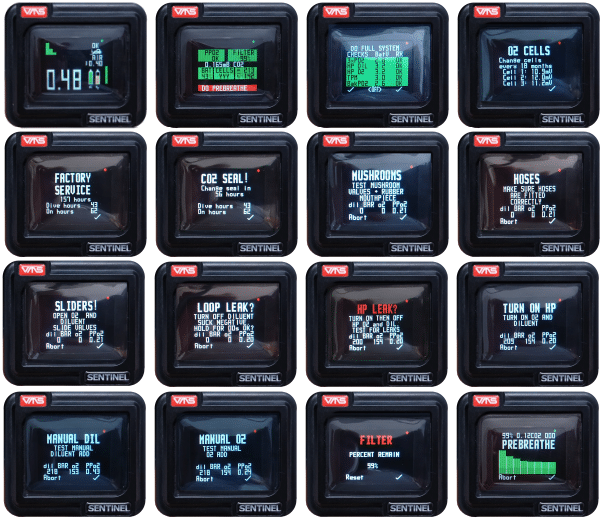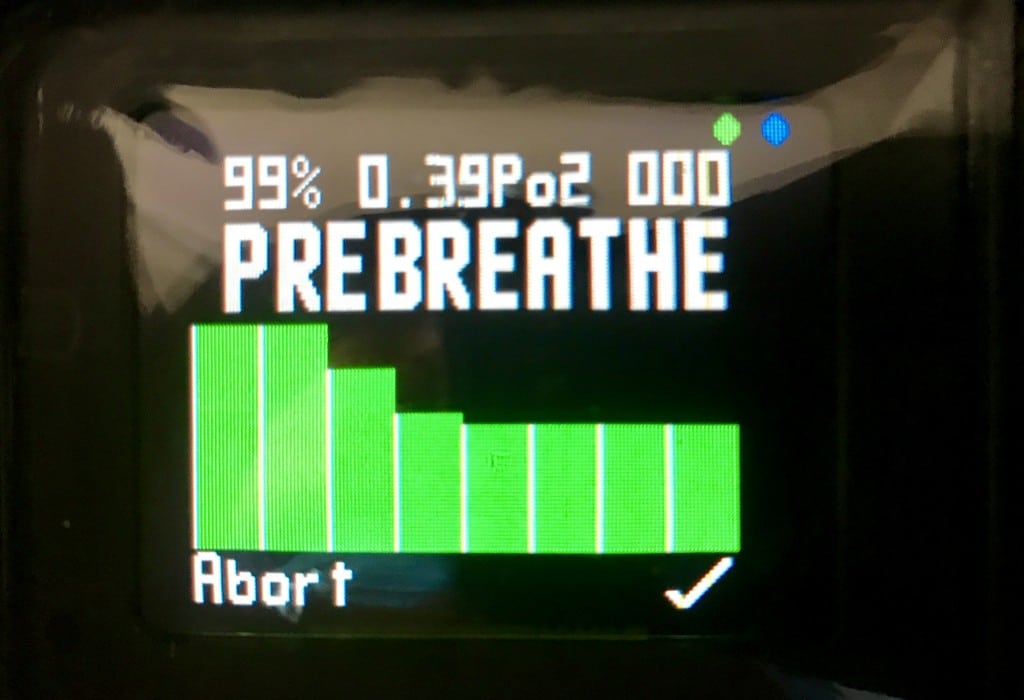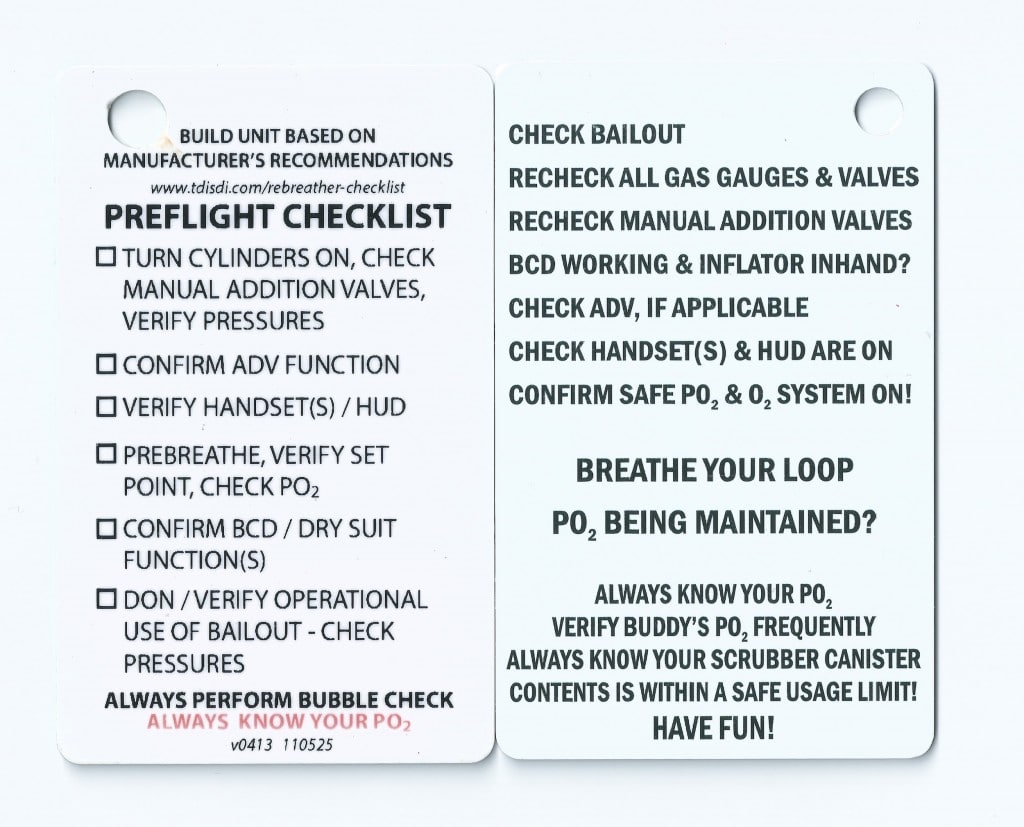News
Rebreather Pre-Dive Checks

The following is a discussion and review of the subject of Pre Dive checks when diving rebreathers – a much discussed, varied and often controversial matter!
When we first learn to dive, the concept of a buddy check, pre dive check or safety drill is installed in us as a means to make the dive safer by spotting potential problems before they can manifest and potentially evolve into accidents.
This is not a procedure limited to diving, it is extremely common in the Aviation, Aerospace and military communities, but to bring it closer to home it is present when we drive a car. When we drive a simple, mainly mechanical, car we are aware of the pre drive steps of checking the coolant level, the tyre pressures and the oil level and then adjusting the seat, wing and rear view mirrors to the individual driver. In a more modern, computer controlled car, many of these checks may be completed by the control system and communicated to the driver via dash board instrumentation and at the high end, even the seat and mirror settings can be altered to individual drivers with the push of a button. What is most common is a combination of automated computer generated checks and manual human checks; either way we are assured of the functionality of the vehicle before heading out on the road.
With rebreather technology the source of the pre dive check sequence and method could come from a variety of places. The manufacturer of the specific rebreather, a training agency that teach a specific rebreather, a generic training agency rebreather check list to suit all rebreathers and a learnt acronym to prompt the required checks.
Of course it would be best if available to use the specific rebreather check list or system supplied by the manufacturer.
Within the above there are different ways to complete checks:
- A written check list
- A check list acronym – e.g a common rebreather check list reminder is the acronym of F.L.A.G.S.
- Flow
- Loop
- Analyse
- Gauges
- Stack/Sensors
- Electronic check lists within the rebreathers display

- Electronic check lists that analyse data from the actual components of the rebreather.

What should be checked?
Pre-Assembly
Mushroom (One Way) Valves. The one way check valves within the Mouthpiece assembly that ensure the gas flows around the rebreather in a single correct direction should be tested to ensure they open with and close against FLOW.

The Oxygen, Diluent, Single supply gas and all bailout cylinders for the planned dive should be ANALYSED.
The absorbent canister (STACK) should be either re-packed or replaced. Or the used time of a previously used canister should be noted and the remaining time available compared to the dive plan.
Pre-Dive
There are as many pre dive check sequences as there are rebreathers, in fact many more! So for initial discussion of the steps of pre dive checks we will here use the acronym FLAGS as a starting point. Although not exhaustive if the printed check sheets or on screen check prompts of most of the currently available rebreathers are reviewed all steps within them can be classified under one of the following prompt words:
F – FLOW
Ambient pressure gas flow around the rebreather in a single correct direction. Tested with the Mushroom (One Way) valve check as part of Pre Assembly. This should be tested prior to each dive as stray granules of absorbent etc could compromise a Mushroom Valve.
High pressure and intermediate pressure gas flow around the rebreather. Slowly turn on the cylinder valves and then add Diluent and Oxygen manually, inflate and check dumps on BCD/wing, check that the ADV and BOV function and ensure the solenoid can inject oxygen where applicable to each specific type of rebreather.
L – LOOP
Conduct a negative loop test and a positive loop test where appropriate to each style of rebreather.
A negative test is conducted on a completely assembled rebreather by placing the mouthpiece in the rebreather or closed circuit position and breathing in through the mouth (To empty the loop) and out through the nose until the loop is empty and then closing the mouthpiece. A suitable period of time (A minimum of 1 minute) is allowed to pass and the rebreather should maintain that negative i.e. not leak air into to rebreather.
Indications of a good negative can include, crushed breathing hoses, ADV diaphragm remaining concave or in, a lower PO2 than ambient (e.g. Pre negative mouthpiece open PO2 0.21, during negative mouthpiece closed 0.19) and a strong ‘gasp’ or sucking sound when opening the mouthpiece at the end of the check.
A positive test is conducted on a completely assembled rebreather by placing the mouthpiece in the rebreather or closed circuit position and breathing in through the nose and out through the mouth until the loop is full and then closing the mouthpiece. A suitable period of time (A minimum of 1 minute) is allowed to pass and the rebreather should maintain that positive i.e. not leak air out of rebreather.
Indications of a good positive can include rigid inflated counter lungs.
A – ANALYSE
The Rebreather although containing Oxygen sensors must not be used to analyse the gases used within the rebreather.
All gases, Oxygen, Diluent and all bailouts should be analysed and labeled prior to being assembled into the rebreather or as bailouts with an Oxygen or where required an Oxygen/Helium analyser.
Many rebreathers are calibrated by flushing them completely or flushing a sensing chamber where the sensors sit with Oxygen at Ambient pressure, if this were completed with a gas supply other than specified (i.e. Oxygen) then the calibration would be inaccurate and therefore the PO2 incorrect during the dive.
G – GAUGES
Test the contents of all required cylinders, Oxygen, Diluent and all required bailout and check for leaks.
Turn on (Slowly) cylinder valves and note the reading of pressure.
Turn off cylinder valves and leave off for 1 minute.
Check contents pressure has not dropped (If the pressure has dropped there is an HP or IP leak to be located and resolved)
S – STACK / SENSORS
The rebreather should be tested for basic function by the Pre Breathe detailed below.
The purpose of this check is to watch the 3 sensor outputs for stabilisation, correct reading and change on prompt i.e. whist breathing add Oxygen and note a rise in PO2 and then add Diluent and note a drop in PO2 from set point.
If fitted during the Pre Breathe a Carbon Dioxide sensor can be monitored for a rising figure.
Again if fitted on the specific rebreather a thermal activity monitor ‘Temp Stick’ can be monitored to ascertain the exothermic reaction of the sofnolime absorbing Carbon Dioxide causing thermal sensors within the stack to register a rise in temperature.
Pre-Breathe
The fully assembled Pre Dive checked rebreather should be breathed for an adequate time to assure the user of systems functionality.
This is the period when the above Stack/Sensors tests are performed.
Current research would indicate that a part used, over used, poorly packed, incorrectly fitted or even absent stack may not give enough signs or symptoms of Hypercapnia during a 3-5 minute Pre Breathe to ensure a diver notices and considers the rebreather unfit for use.
Quick Pre Jump Confirmation
Many training agencies provide Pre Jump quick check prompt cards that can be attached to the Rebreather.

Steps on these include but are not limited to:
- Cylinder valves fully open on Oxygen, Diluent, Single supply gas and bailout?
- Electronics on and safe breathable PO2 displayed?
- BCD inflated?
- Mouthpiece in mouth and in rebreather position?
These Pre Jump checks are NOT considered a full Pre Dive check and are in no way meant to replace full Pre assembly, Pre Dive and Pre Dive checks. The Pre Jump is intended to be used in addition to normal checks as a last check just prior to water entry.
Find out more about Phil at www.philshorttechnical.co.uk.
News
Dive Worldwide Announces Bite-Back as its Charity of the Year

Over the next 12 months, specialist scuba holiday company Dive Worldwide will be supporting Bite-Back Shark & Marine Conservation with donations collected from client bookings to any one of its stunning dive destinations around the world. The independently-owned operator expects to raise £3000 for the UK charity.
Manager at Dive Worldwide, Phil North, said: “We’re especially excited to work with Bite-Back and support its intelligent, creative and results-driven campaigns to end the UK trade in shark products and prompt a change in attitudes to the ocean’s most maligned inhabitant.”
Bite-Back is running campaigns to hold the media to account on the way it reports shark news along with a brand new nationwide education programme. Last year the charity was credited for spearheading a UK ban on the import and export of shark fins.
Campaign director at Bite-Back, Graham Buckingham, said: “We’re enormously grateful to Dive Worldwide for choosing to support Bite-Back. The company’s commitment to conservation helps set it apart from other tour operators and we’re certain its clients admire and respect that policy. For us, the affiliation is huge and helps us look to the future with confidence we can deliver against key conservation programmes.”
To launch the fundraising initiative, Phil North presented Graham Buckingham with a cheque for £1,000.
Visit Dive Worldwide to discover its diverse range of international scuba adventures and visit Bite-Back to learn more about the charity’s campaigns.
MORE INFORMATION
Call Graham Buckingham on 07810 454 266 or email graham@bite-back.com
Gear News
Scubapro Free Octopus Promotion 2024

Free Octopus with every purchase of a SCUBAPRO regulator system
Just in time for the spring season, divers can save money with the FREE OCTOPUS SPRING PROMOTION! Until July 31st SCUBAPRO offers an Octopus for free
with every purchase of a regulator system!
Get a free S270 OCTOPUS with purchase of these combinations:
MK25 EVO or MK19 EVO with A700
MK25 EVO or MK19 EVO with S620Ti
MK25 EVO or MK19 EVO with D420
MK25 EVO Din mit S620Ti-X
Get a free R105 OCTOPUS with purchase of the following combinations:
MK25 EVO or MK19 EVO with G260
MK25 EVO or MK17 EVO with S600
SCUBAPRO offers a 30-year first owner warranty on all regulators, with a revision period of two years or 100 dives. All SCUBAPRO regulators are of course certified according to the new European test standard EN250-2014.
Available at participating SCUBAPRO dealers. Promotion may not be available in all regions. Find an authorized SCUBAPRO Dealer at scubapro.com.
More information available on www.scubapro.com.
-

 News3 months ago
News3 months agoHone your underwater photography skills with Alphamarine Photography at Red Sea Diving Safari in March
-

 News3 months ago
News3 months agoCapturing Critters in Lembeh Underwater Photography Workshop 2024: Event Roundup
-

 Marine Life & Conservation Blogs3 months ago
Marine Life & Conservation Blogs3 months agoCreature Feature: Swell Sharks
-

 Blogs2 months ago
Blogs2 months agoMurex Resorts: Passport to Paradise!
-

 Blogs2 months ago
Blogs2 months agoDiver Discovering Whale Skeletons Beneath Ice Judged World’s Best Underwater Photograph
-

 Gear Reviews2 weeks ago
Gear Reviews2 weeks agoGEAR REVIEW – Revolutionising Diving Comfort: The Sharkskin T2 Chillproof Suit
-

 Marine Life & Conservation2 months ago
Marine Life & Conservation2 months agoSave the Manatee Club launches brand new webcams at Silver Springs State Park, Florida
-

 Gear Reviews3 months ago
Gear Reviews3 months agoGear Review: Oceanic+ Dive Housing for iPhone
















